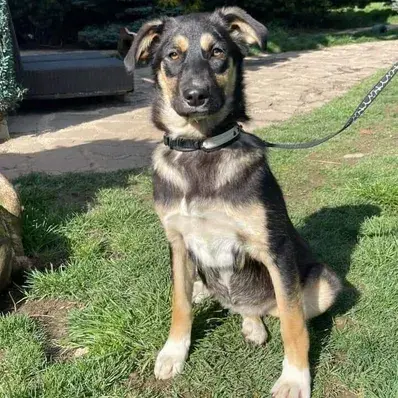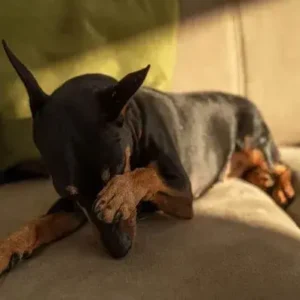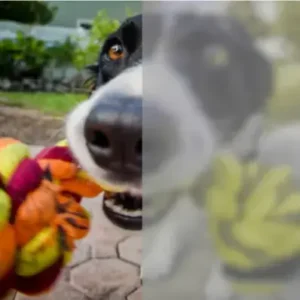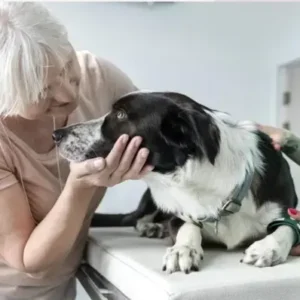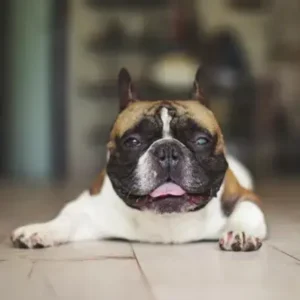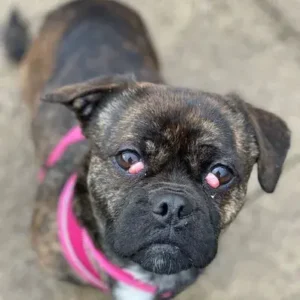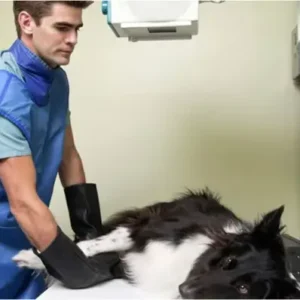Symptoms of Canine Gastric Torsion
Recognizing the clinical signs of gastric torsion early can save your dog’s life. Symptoms often develop quickly and worsen within hours.
Some common symptoms include:
Immediate Signs
- Rapid breathing and restlessness: Dogs may appear anxious or have trouble settling down.
- Abdominal distention or swelling: The dog’s belly may appear bloated and firm to the touch.
- Unproductive vomiting or retching: Dogs with gastric torsion often attempt to vomit, but nothing comes up.
- Excessive drooling: A dog in distress may drool excessively due to the pain.
Advanced Symptoms
- Weakness or collapse: The dog may become very weak and struggle to stand or walk.
- Pale gums and cardiac arrhythmia: Reduced blood flow can cause shock, making the gums appear pale and the heart rate increase.
Causes and Risk Factors
Certain dogs are more prone to developing gastric torsion due to their breed, size, and lifestyle. The exact cause isn’t always clear, but some common risk factors include:
Predisposed Breeds
Large, deep-chested dog breeds are more likely to develop gastric torsion, including:
- Great Dane
- Doberman
- Boxer
- Saint Bernard
- Irish Setter
Other Risk Factors
- Age: Older dogs are more likely to suffer from gastric torsion due to decreased gastric motility.
- Diet: Large meals and feeding one big meal a day can increase the risk.
- Exercise after meals: Vigorous physical activity shortly after eating can contribute to the condition.
- Hypothyroidism: While hypothyroidism doesn’t directly cause gastric torsion, it can contribute to conditions that increase the risk of bloating, which may lead to torsion.
- Disseminated Intravascular Coagulation: DIC is a severe clotting disorder that can result from gastric torsion, causing widespread bleeding and clotting
Diagnosis of Gastric Torsion
If you suspect your dog may have gastric torsion, seek immediate veterinary care. A veterinarian will conduct a physical exam and may use imaging techniques such as X-rays or ultrasound to confirm the diagnosis. The vet will look for signs of stomach distention and twisting, which are characteristic of gastric torsion.
In some cases, the veterinarian may need to rule out other conditions such as pancreatitis or heart failure, which can present with similar symptoms.
Treatment of Canine Gastric Torsion
Gastric torsion is a medical emergency that requires immediate treatment. The treatment approach typically involves stabilizing the dog, decompressing the stomach, and addressing any complications.
Immediate Veterinary Care
- IV fluids and stabilization: The dog will be given fluids to correct dehydration and restore blood pressure.
- Decompression: A tube may be inserted into the stomach to release the trapped gas, or the vet may perform a needle decompression if the situation is critical.
Surgery
The most common treatment for volvulus in dogs is surgery, where the stomach is untwisted and any damaged tissue is addressed. In some cases, a procedure called gastropexy is performed prior to surgery. This involves attaching the stomach to the body wall to prevent future twisting.
Post-Operative Care
After surgery, your dog will require monitoring to ensure that no further complications arise. Dietary changes and gradual reintroduction of food will be necessary. Your vet will provide guidelines on post-operative care to promote healing.
Prevention of Canine Gastric Torsion
While some factors, such as genetics, can’t be controlled, there are several ways you can reduce the risk of gastric torsion in your dog:
Dietary Adjustments
- Smaller, frequent meals: Feed your dog small meals portions throughout the day instead of one large meal.
- Slow down eating: Use slow feeders or puzzle bowls to prevent your dog from eating too quickly.
Avoid Exercise After Meals
Ensure that your dog has at least an hour of rest after meals before engaging in physical activity.
Prophylactic Surgery (Gastropexy)
For high-risk dogs, particularly those prone to gastric torsion, a gastropexy may be recommended as a preventive measure. This surgery involves tacking the stomach to the abdominal wall, significantly reducing the chances of future twisting.
Prognosis for Dogs with Gastric Torsion
With prompt treatment, many dogs can recover fully from gastric torsion. However, the condition is often fatal if not treated immediately. The survival rate for dogs with GDV that receive timely veterinary intervention is generally high, but recovery depends on the severity of the condition and the dog’s overall health.
Long-term care will focus on monitoring for any recurrence of symptoms and adjusting diet and exercise habits to reduce the risk.

